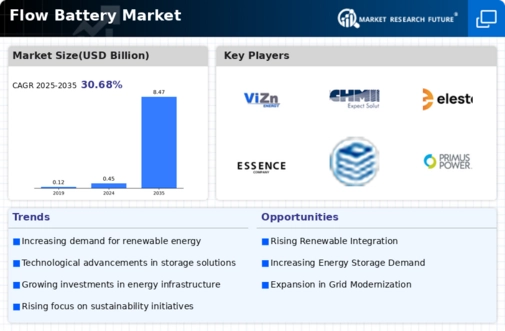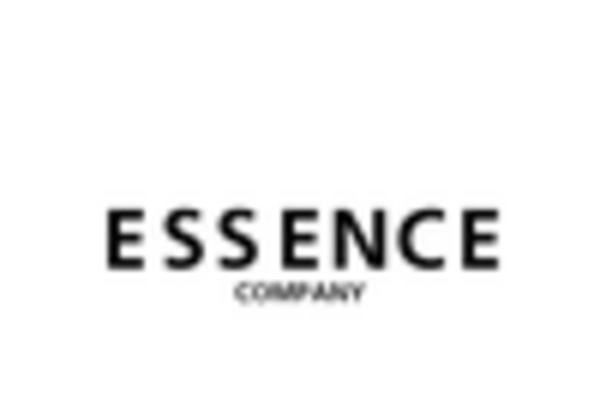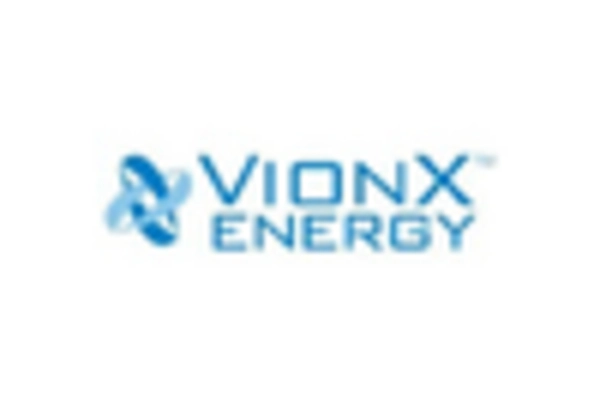Market Analysis
Flow Battery Market (Global, 2025)
Introduction
The Flow Battery market is expected to play a key role in the global energy industry, owing to the growing demand for sustainable and efficient energy storage solutions. As the world turns to more sustainable energy sources, reliable storage solutions are becoming increasingly important to balance the inconsistency of solar and wind energy. With their unique design and performance advantages, Flow batteries are a viable alternative to other storage systems, especially in the large-scale applications. Their long-term energy storage capability, along with a longer life cycle and reduced environmental impact, makes them a critical part of the energy transition. Meanwhile, the advancements in the technology and the reduction in the cost of production are expected to further increase the competitiveness of flow batteries, making them an attractive option for utilities, commercial enterprises, and households. As the importance of energy security and sustainability grows across industries, the Flow Battery market is expected to experience significant growth, shaping the future of energy storage.
PESTLE Analysis
- Political
- In 2025, governments began to favor the use of energy from the sun and wind, and more than thirty countries had already begun to encourage the use of flow batteries for energy storage. For example, the U.S. Department of Energy allocated $ 1.5 billion in research and development funds for energy storage. It was expected that the flow battery market would grow a lot. Moreover, international agreements on reducing carbon dioxide emissions were influencing national policies, thereby creating a more favorable regulatory environment for the use of flow batteries.
- Economic
- The flow batteries were a great improvement over the zinc-bromine batteries and the cost was less than that of zinc-lead batteries. Flow batteries had fallen by 20 percent in price since 2023. Now they cost about $300 per kilowatt hour and were more competitive with the more traditional storage batteries. The growing number of jobs in the industry meant that employment in the field of renewable energy had increased by 15 percent. Energy storage and related industries had created more than 200,000 new jobs.
- Social
- In 2025, the public's knowledge and acceptance of renewable energy sources is at its highest point, with a survey indicating that 75 per cent of consumers are in favour of energy storage systems such as flow batteries. People are increasingly concerned about climate change and wish to be energy independent. In addition, educational and community programmes have increased in number, and more than 1,000 local governments have set up energy education programmes that also include information about the benefits of flow batteries.
- Technological
- In the field of flow batteries, the efficiency and duration of the batteries have been improved by new designs, and by 2025 they will have energy densities of up to 50 Wh/L. In the field of flow batteries, the development institutions and companies have made great efforts, and the amount of research and development in the field of flow batteries in the last year is about 500 million dollars. The performance of the flow batteries has been greatly improved, and they are suitable for large-scale energy storage, grid-connected applications, and the integration of solar energy.
- Legal
- In 2025, the legal framework for the energy storage systems is becoming more stable, and twenty countries have enacted specific regulations to encourage the use of flow batteries. These regulations include simplified procedures for obtaining building permits and the setting of safety standards for the installation of the batteries. Also, the European Union has issued a directive requiring that all new energy storage systems meet certain safety and environment requirements. This has an effect on the flow battery manufacturers and developers.
- Environmental
- The environment-friendliness of the flow batteries is a progressively better one, since their life-cycles are calculated to be as much as forty per cent less than that of the lithium-ion batteries. By 2025, the flow battery’s components are expected to be recycled to the extent of sixty per cent, thereby reducing waste and increasing the environment-friendliness. Furthermore, the use of non-toxic materials in the production of flow batteries is increasing. Seventy per cent of the new flow batteries are expected to use environment-friendly substances, in line with the global goals of sustainable development.
Porter's Five Forces
- Threat of New Entrants
- The Flow Battery Market in 2025 is Expected to Have Moderate Barriers to Entry. The technology is becoming more accessible, but substantial capital and knowledge of energy storage systems are still needed. The leading players have a competitive advantage due to their brand recognition and existing customer base.
- Bargaining Power of Suppliers
- The bargaining power of the suppliers in the flow battery market is relatively low. Suppliers of the required components, such as vanadium and other chemicals, are distributed, which limits the dependence on a single supplier. Also, new technology developments may lead to alternative materials, further reducing the bargaining power of suppliers.
- Bargaining Power of Buyers
- Flow battery buyers have a high degree of power, due to the growing number of products and the increasing competition among the manufacturers. In the future, as more companies enter the market and the level of technology increases, the market will be more and more dominated by the buyers.
- Threat of Substitutes
- The threat of substitutes for the flow batteries is moderate. Other energy storage solutions, such as lithium-ion batteries and pumped-storage hydropower, do exist, but flow batteries have unique advantages such as a higher degree of cyclability and scalability. The rapid technological development of competing energy storage solutions could, however, pose a threat to flow batteries if they become more cost-effective.
- Competitive Rivalry
- Competition in the flow battery market will be high by 2025. The number of market players is increasing, and this will result in a race for market share, which will lead to aggressive price competition and continuous innovation. Competition in this market will be fierce, and this will push the market forward. Companies are investing heavily in research and development to differentiate their products, and this will intensify competition and drive the market forward.
SWOT Analysis
Strengths
- High energy storage capacity suitable for large-scale applications.
- Long cycle life and low degradation rates compared to traditional batteries.
- Ability to discharge energy over extended periods, making them ideal for renewable energy integration.
Weaknesses
- Higher initial capital costs compared to conventional battery technologies.
- Complexity in system design and installation may deter adoption.
- Limited awareness and understanding among potential users and investors.
Opportunities
- Growing demand for renewable energy sources and energy storage solutions.
- Government incentives and policies promoting clean energy technologies.
- Technological advancements leading to cost reductions and improved efficiency.
Threats
- Intense competition from other energy storage technologies, such as lithium-ion batteries.
- Potential supply chain disruptions for key materials used in flow batteries.
- Regulatory challenges and changing energy policies that may impact market growth.
Summary
Flow batteries are characterized by their high energy storage capacity and long life cycle, which makes them ideally suited for the large-scale storage of renewable energy. But the high initial cost and the complexity of installation can be a hindrance to their wider use. Opportunities arise from the growing demand for energy storage solutions and the support of the government, while threats come from competing technology and the regulatory environment. Strategic focus is on reducing costs and increasing the awareness of users.

















Leave a Comment